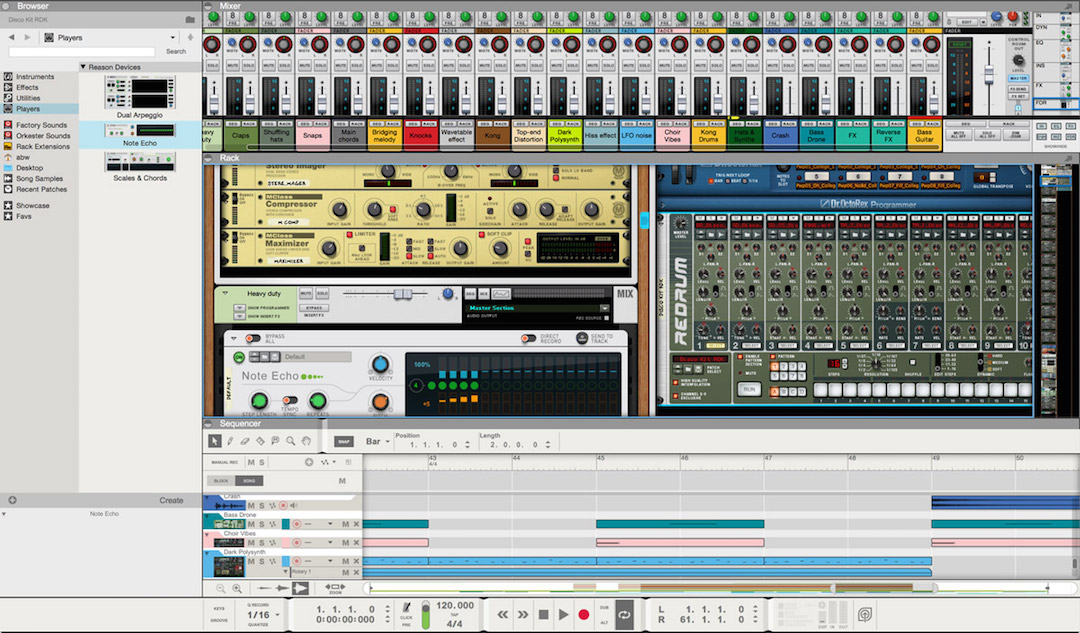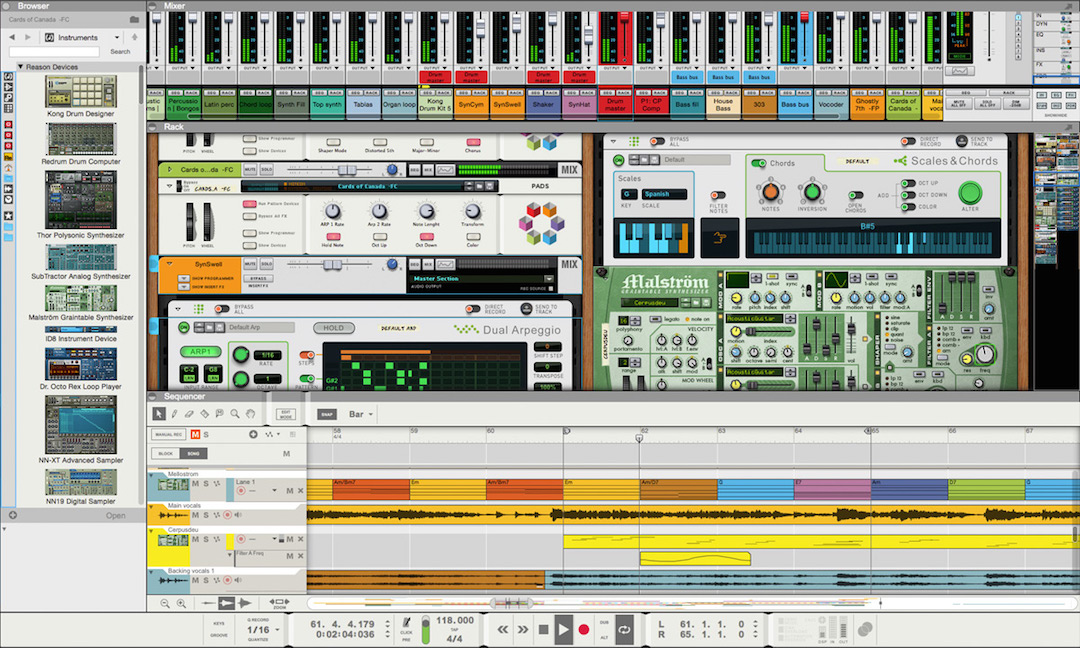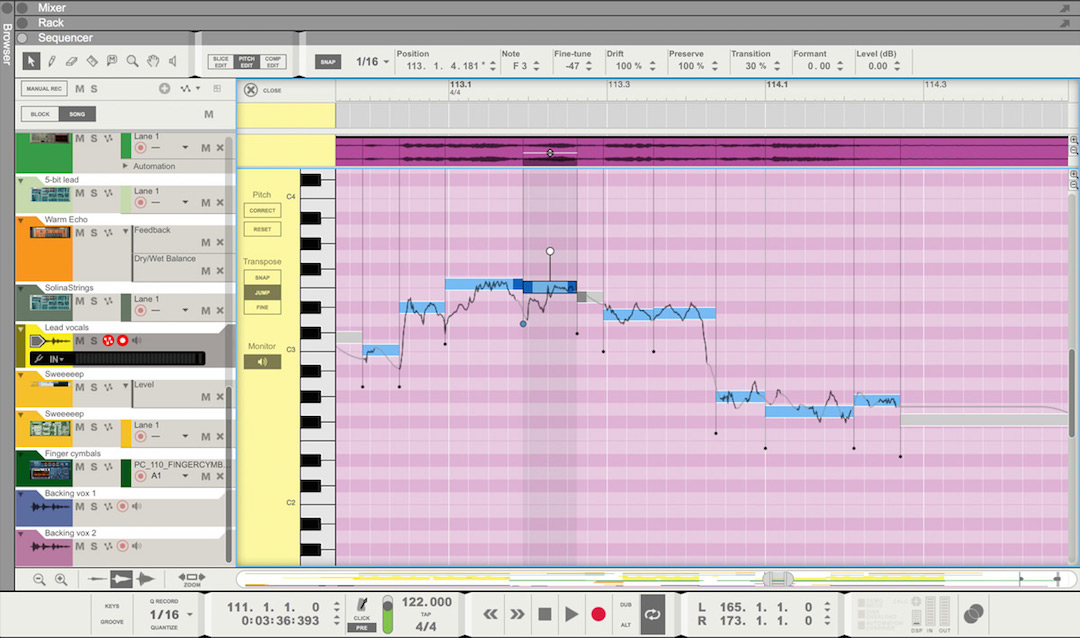New Software Review: Reason Version 9 from Propellerhead
I’ve always been a big fan of Propellerhead’s Reason software. Though I never fully understood all its ins and outs in the past, I still regularly used it as a synth engine and as a Rewire tool within Ableton.
With Reason, Propellerhead created a platform that seems to have convinced so many producers that they just don’t need hardware anymore. With innovative synth engines and limitless custom patching options, Reason quickly became a DAW in a class all its own, allowing musicians to easily explore its deep sonic capabilities.

A view of Reason 9, showing its mixer, effects and instrument racks and editor, all in one consolidated window.
In its many early versions, Reason was always that one weird audio program that you couldn’t actually record audio into. That all changed in version 6 with the addition of more rack units, audio recording capabilities, and a fancy new mixer.
Now in its 9th release, Propellerhead has pushed Reason into the main arena of modern DAWs, making it less of a complicated sequencer for producers, and more of a streamlined, yet complete workstation with some beautiful and unique features.
In its past versions, Reason seemed to resonate most with those who were already acquainted with navigating DAWs on some level. Now, practically anyone looking to create music in almost any genre can easily work with Reason. New features such as pitch editing, MIDI devices, and a gorgeous new browser system make Reason 9 the most powerful and innovative iteration so far.
Editor’s Note: In Spring 2017, Propellerhead released Reason 9.5, which added VST support to Reason, allowing the use of third-party plugins for the first time in the program’s history.
Interface
Reason 9’s layout is packed, to say the least.
Everything is stacked into one window: A sequencer, racks, a mixer, and a browser. This can all be separated into individual windows however, which looks awesome on a multi-display setup.
The browser is especially nice, organizing sound libraries, samples, and user locations very neatly. The mixer and multi-rack setups make routing and organizing very easy, and the sequencer window has become even more intuitive to navigate.
Additionally, new visual themes give you some great alternative options for the overall look of the interface (the dark theme looks pretty cool with all the lights off, just sayin’).
Pitch Edit and Player Devices
One amazing new feature that Propellerhead has built into version 9 is the Pitch Edit mode, accessible in the sequencer window. This feature allows you to fix out-of-tune notes, create amazing harmonies, and even change the vibrato and dynamics of a track.
Essentially, it’s a pretty decent version of Melodyne built right into Reason 9, allowing the quick editing of pitches and positions of notes. While not quite as detailed as Melodyne itself, Pitch Edit mode is still a very handy tool to have with just one click in the sequencer window.
My favorite new features in Reason 9 are the Player devices: MIDI tools that route into instruments allowing for even more inspiration and creative sound design.
The Scales and Chords feature allows you to create amazing harmonies and chords out of melodies, giving practically anyone the tools to build songs and sequences.
Note Echo is a gorgeous MIDI delay, allowing you to alter rhythm and pitch for synths and drum/percussion patterns.
Dual Arpeggio combines two very powerful polyphonic arpeggiators into one amazing device, opening up the concept of an arpeggiator to create beautiful polyrhythms. I messed around with these for quite some time, and found it extremely intuitive to create arpeggios and chords that would otherwise take me hours to achieve.
Creative Flow
The one major thing I’ve always loved about Reason is that it’s totally modular. The patch view on the “back of the racks” makes the program stand out among other modern DAWs.
Though it takes some time to understand, digital patching is a beautiful feature that has helped define Reason through the years. Along with this, Reason has introduced a number of other features that offer a faster, more creative workflow for the user.
The new bounce in place feature is a great tool for creating audio tracks immediately from MIDI instruments and drum racks. This, for me, is pretty huge.
Back in the day, I used to individually solo tracks and export them from the session. Now, there are a few different options available for stemming out a mix or individual tracks for live use: You can bounce in place, or you can also bounce mixer channels, setting parameters for what you want to bounce and where you want the stems to go.
Reason 9 also features audio to MIDI! You can now sing a melody and convert it to MIDI in one single click. This was really fun to try out, though at 9 AM my voice was tired, so it took a bit of time for me to get the pitches right. Audio to MIDI is yet another great feature that allows for maximum creative flow with minimal technical hurdles.
New Sounds
Though I’m not big on presets, Reason 9 offers 1,000 new sounds for its instruments. Combinator instruments are especially neat, sometimes combining several synth engines into one via a mixer and some effects processors.
I like to think that Reason presets are great tools for understanding how the built-in instruments work and how to best route them. When I first started working with Reason, I remember opening up Thor and thinking “What the heck did I just purchase?”
Thor, Malström, and Subtractor look pretty intimidating, however in reality they’re actually very easy to use. I’ve found that the best way to understand them is to open a preset you like and see how it was built.
Other staples like the Kong Drum Designer and the Dr. Rex Sample Player boast some new sample sets as well. Adding a Dual Arpeggio onto a Kong was a really cool way to introduce new rhythms to my sequences, and the Note Echo was especially fun on hi hats and snares.
Rack Extensions also offer a plethora of sounds and effects for Reason. Plenty of developers like Korg, Softube, and McDSP offer their famous devices for use in the Reason platform, and they connect just like any other rack would.
Summing Up
Reason seems to have always had a cult-style following. In electronic music especially, it hasn’t had as big of an impact as Ableton has had on the market, in my estimation due to its intricate patching and timeline features. Reason 9, however, offers a more streamlined interface that leans further towards creative control.
I would recommend this software to anyone looking to get into serious electronic music production. As for those who are fully committed to Ableton, I urge them to think of Reason as another creative toolbox full of inspiring sounds. With the myriad of new MIDI and effect capabilities, the possibilities within Reason 9 are endless.
John Jagos is a producer, engineer and electronic musician who lives in Brooklyn, New York and performs under the name Brothertiger.
Please note: When you buy products through links on this page, we may earn an affiliate commission.









timo boehme
November 24, 2016 at 4:07 am (8 years ago)Nice article. As I understand you are not a new user in Reason. When I started with Reason 4, it comes lightweight and simple when turning from real Rack hardware sound generator into Reason 4.0. Today for new users it feels to mixed with old and new stuff and not clean and lightweigt anymore. While you are right with all facts in what is possible to do, it is not clean for new users. I really recommend Propellerhead to cleanup old devices to backup menu and just work with new 10 devices and effects. I will update to 9 in some time. But it is really a bad way of developing to only implement new stuff above the old. I really like the new dongle concept. And I like the cables behind all. I love Reason. But they will not get enough new users with this version. That is really a pitty.